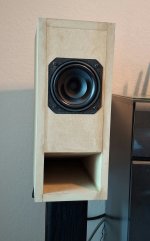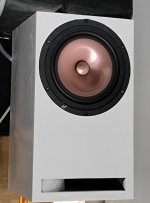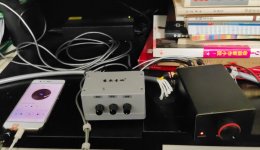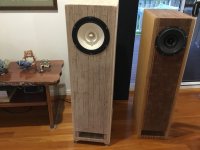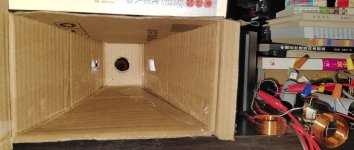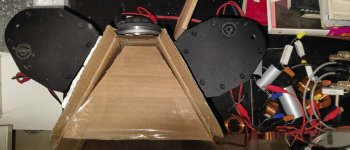I've used plastic and lead prior in experiments. My FH3s are pretty dead with 15mm Baltic birch but do still shimmy a skosh more than my other horns. Such mods are over on these cabinets at this point though ~ they are sealed up and while I'll mod some stuffing, I can't lay in much more lining. I might try thicker material (that's accessible) behind the driver. Work for when I do the bass trap/room placement experiment you recommend. Your curve is tight... maybe I'm just less discriminating (ref: "wild"). 🙂and 1 layer of thin plastic vibration absorber. I don't claim that those speakers above have any resonance problems, but if they have, that is my solution.
Yeah... horns are the shizzle. I EQed the walls out with DSP before moving the boxes... but will so do. Too, for the "wild" curve, the MAP7s are smoother, but even here with the TB1337s (except for the weird 9.5K drop) they're cool IMO. I can smooth them further with DSP but was bored with that ~ I lost dynamics; I leave further acoustic variations to a swap back to Mark Audio and addition of damping material behind the driver. Are you baiting me? "Wild" ~ seems decent for 5m from $100 horns driven by a 4w amp unadulterated... this kit rocks.the horn cabinet technology is delivering. 200 Hz area fluctuations are probably the wall reflections, could you pull them from the wall and throw some pillows in the corners, just for sake of measurement? I think you can dramatically improve everything under 500 Hz just with hand waving.
But the rest of the curve above 500 Hz looks too wild
Last edited:
Frugel-Horn lite with Alpair 5.Baffle made out of 24mm solid alder I recycled from an old kitchentable. Also new listening space where these little singers interact quiete nicely with the room.
I need more carpet.



I need more carpet.
Whats up with europeans and fullrange drivers? They just loveeeeeeeeee that!
Actually yes, that's why the speaker is limited to the bottom with a 470uF electrolytic capacitor
Monacor Broadbandspeaker
(Cheap Trick 193)
Monacor SPH-60X

(Cheap Trick 193)
Monacor SPH-60X
Visaton Solo 20
The B200 really benefits by adding these: https://www.planet10-hifi.com/downloads/B200-phase-plug.pdf
https://p10hifi.net/tlinespeakers/FAL/B200-surgery/B200-surgery.html
dave
Attachments
Unfortunately I don't have a lathe. Are there any places where I can buy these phase plugs?The B200 really benefits by adding these: https://www.planet10-hifi.com/downloads/B200-phase-plug.pdf
https://p10hifi.net/tlinespeakers/FAL/B200-surgery/B200-surgery.html
dave
This is awesome @alsyd I was actually looking at a similar speaker from New Fidelity over the weekend thinking, maybe I could make something similar and you have already done it!

My latest project: an omni-directional wireless speaker. It's not finished but I just did a first test and am too excited not to make a post!
I wanted a speaker for the kitchen and after evaluating some commercial offerings I ended up pilfering a Pluvia 11 driver from my boombox build (post #4871) and designed an ~8L enclosure myself. The first design iteration had a port but I've never done a passive radiator speaker before and figured this was a perfect opportunity. A close friend is in to 3D printing and recently acquired a Bambu Lab P1S - an impressive machine - and 3D printed the enclosure using PLA-CF (carbon fibre reinforced PLA). There was a print error on the inside of the PR mounting but I am content with it.
The first test was to assemble the parts, tape the enclosure halves together, and give it a test run. It sounds excellent! Despite a small air leak around the 3.5mm jack passthrough, the bass is really punchy and the 360 effect from the cone absolutely works. I really expected the deflected sound from the cone to muffle the higher end of the output but it's very crisp. The PLA-CF is extremely stiff and doesn't appear to resonate, but I will probably experiment with some deadening material on the inside surface anyway.
The pictures don't do it justice; it's big! Dimensionally, the total height from the bottom of the feet to the top of the cone is 475mm (18.7") and the outside diameter of the enclosure is 205mm (8"). If anyone is interested in making their own I have attached the STL files.
The job list is pretty short - fix the leak, glue the halves together, and experiment with stuffing/deadening. I do have a healthy love for woodworking, but I must admit developing this design in CAD and assembling it in about an hour after getting the parts together was extremely satisfying. Oh, and last point... Its party trick is that the cone is printed using Phosphorescent PLAIt will almost light a corner in a room when it is charged up!
Last edited by a moderator:
My latest project: an omni-directional wireless speaker. It's not finished but I just did a first test and am too excited not to make a post!
I wanted a speaker for the kitchen and after evaluating some commercial offerings I ended up pilfering a Pluvia 11 driver from my boombox build (post #4871) and designed an ~8L enclosure myself. The first design iteration had a port but I've never done a passive radiator speaker before and figured this was a perfect opportunity. A close friend is in to 3D printing and recently acquired a Bambu Lab P1S - an impressive machine - and 3D printed the enclosure using PLA-CF (carbon fibre reinforced PLA). There was a print error on the inside of the PR mounting but I am content with it.
The first test was to assemble the parts, tape the enclosure halves together, and give it a test run. It sounds excellent! Despite a small air leak around the 3.5mm jack passthrough, the bass is really punchy and the 360 effect from the cone absolutely works. I really expected the deflected sound from the cone to muffle the higher end of the output but it's very crisp. The PLA-CF is extremely stiff and doesn't appear to resonate, but I will probably experiment with some deadening material on the inside surface anyway.
The pictures don't do it justice; it's big! Dimensionally, the total height from the bottom of the feet to the top of the cone is 475mm (18.7") and the outside diameter of the enclosure is 205mm (8"). If anyone is interested in making their own I have attached the STL files.
The job list is pretty short - fix the leak, glue the halves together, and experiment with stuffing/deadening. I do have a healthy love for woodworking, but I must admit developing this design in CAD and assembling it in about an hour after getting the parts together was extremely satisfying. Oh, and last point... Its party trick is that the cone is printed using Phosphorescent PLAIt will almost light a corner in a room when it is charged up!
Missed this post earlier.
Nice work alysd!
Mark Audio MA-200 in 17L 1.5m TLonken with "strait" port following Elac and AIRS (a Chinese brand) whereby a circular-curved strait constricts then expands the slot port. Toed-in near the corners of a 3.5m-wide room, at the rather small sweet-spot, clean even response ~40hz to 12khz with both ends modestly rolled-off but still playing the right notes nicely (i.e. acoustic instruments covered full-range). Exceptional for a whizzer-less 8" run straight-through without filter/EQ. AlMg cone not as dynamic/articulate as paper cone especially playing low-volume at night (then loudness compensation a must). Not fully run-in yet, marginal A/A/A -3 demerit score.
The TLonken cab used is very close to my Supravox, with a 3cm slot constricted by 1/3 vs 2cm. Quarterwave resonance ~45hz useable to ~40hz (as heard). OCC interconnect & speakerwire.
The TLonken cab used is very close to my Supravox, with a 3cm slot constricted by 1/3 vs 2cm. Quarterwave resonance ~45hz useable to ~40hz (as heard). OCC interconnect & speakerwire.
Belated drawing of the thread-title TLonken, 17L 1.5m-line converted from a very inexpensive but solidly-built (18mm MDF), ready-made labyrinth cabinet. Measurements are inexact and certainly non-optimal. The TLonken has served as a testing platform for "high-powered" (low Qts) 8-inch fullrange drivers including: Supravox, Lowther PM6A, Isred/MKHIFI drum-paper, and Fostex F200A....
During the Chinese New Year holiday I was "idle-fishing" and saw bargain-priced F200A and W300Aii, both models of course NLA/rarely show up/usually very expensive. Turned out to have suffered damage but still...
During the Chinese New Year holiday I was "idle-fishing" and saw bargain-priced F200A and W300Aii, both models of course NLA/rarely show up/usually very expensive. Turned out to have suffered damage but still...
Attachments
Last edited:
addenum: I hooked in a Sharp GF-777 (clone) passive loudness-tone-control which attenuated all but the frequency extremes, degree depending on attenuator volume setting. I have its low-end knob, high-end knob, integrated amp (TPA3221 BTL), and smartphone source (Huawei P10plus streaming WAV) initially all set to max; then lower the source a bit & raise the attenuator volume to find the best frequency response for the volume I desire. Overall a bit more natural and relaxed sounding, at a cost of (maybe) a little bit of coherence and immediacy. Perfect accessory for fullrange speakers.
Shown: heavy-duty power brick; amp; smartphone; loudness-compensator/frequency-extremes tone-control.
Circuit here:
Shown: heavy-duty power brick; amp; smartphone; loudness-compensator/frequency-extremes tone-control.
Circuit here:
In China a taobao store called Lu-ge (osprey song) has a huge selection including about a half-dozen loudness circuits. Some are based on Sharp GF-777. I have one and it sweetened the trebble (as some speaker XO did) without noticeably losing transparency. The passive version with defeat switch may lose too much gain if there's no preamp.
Attachments
Last edited:
Interesting! I found another photo - it's bigger than I thought:This is awesome @alsyd I was actually looking at a similar speaker from New Fidelity over the weekend thinking, maybe I could make something similar and you have already done it!
Of particular interest is the positioning and width of the cone (same diameter as the the enclosure, probably done for aesthetics though). I took a total guess for cone width and height above the driver for my design. I could print some variations to test having the cone closer to the driver or larger widths.
Perhaps a big version with an MA200 is in order!!!
Maybe in the region of 25L, being similar to the Pi-Align vented box standmount. Some quick calcs to get to 25L = internal measurements of 270mm for width, 435mm for height. Could use an 8" DS215-PR passive radiator. I used 6 1/2" DS175-PR which matched the P11 nicely.
My P11 design is ~7L from memory; the P11 doesn’t need much volume.
Last edited:
Don’t remember if I posted my Metronomes here, but I’m listening to them currently so here’s a photo of my system


I have a Tang Band 6.5” ten foot folded horn for a sub and Tang Band 4” Bamboo bipolar Meteonomes. The electronics were all built by me too with a FirstWatt Burning Amp 3 Preamp, a Burning Amp 3 amp (@32 volts), an XRK class D amp, Salas Ultra FSP phono stage, and a Marantz TT15 turntable. Also in the photo is an M&K sub, Jeff’s Continuum speakers, a Nutube pre and a Nutube/Class D hybrid amp.
I have a Tang Band 6.5” ten foot folded horn for a sub and Tang Band 4” Bamboo bipolar Meteonomes. The electronics were all built by me too with a FirstWatt Burning Amp 3 Preamp, a Burning Amp 3 amp (@32 volts), an XRK class D amp, Salas Ultra FSP phono stage, and a Marantz TT15 turntable. Also in the photo is an M&K sub, Jeff’s Continuum speakers, a Nutube pre and a Nutube/Class D hybrid amp.
@ Soundwavesteve, I love ❤️ that purple colour in one of the photos… I have wanted to make a straight pipe, but I have Fear of the wife!!!
My latest 2 projects, The latest with the Sonido Field Coil driver ( white) is still in raw timber… still trying to decide on the right finish… my feeling is that oil sounds nicer than varnish….. The other one is finishing in Boiled Linseed Oil..
My latest 2 projects, The latest with the Sonido Field Coil driver ( white) is still in raw timber… still trying to decide on the right finish… my feeling is that oil sounds nicer than varnish….. The other one is finishing in Boiled Linseed Oil..
Attachments
For some time now I've wanted to compare my reflector-coaxial PrimeRadiant against another quasi-coherent-point-source 2-way, the Multi-Entry-Horn. I can't really do the MEH justice, but here's a Minimalist MEH (Minmei) experiment done over three sessions, listening and tweaking the passive filters to tame back flat the horn-bloat FR -- a rather fool-hardy challenge. But it has been fun and the result extremely vivid, detailed, and dynamic -- if not "holographically deep" like my coherent speakers or a really good fullrange driver. I did more-or-less time-align the drivers but phase would have to wait (other than flattening FR by ear).
HornFaital: HF108; two Admark LDA-401 array units 4" Faital-inside (nominal 8ohm but closer to 12 around 1khz); horn mouth (cm) 22W 12H 15D, back ~6x7 with 2.5 round throat-hole, ~1.8 entry taps ~8.5 apart. Mids are separated from the horn cardboard by styrofoam so as to time-align with the CD (by ear, playing 3khz without XO) and to make them fit. The horn shape was tweaked in real-time; even 1° from optimal made an audible difference near-field 0.5m (by ear, anyway). Most of the effort was notching out horn-bloat in concert with XO, trying and chaining together insane number of L/C/R parts.
LP ~1khz 0.9mH->parallel 4" Faital/Admark (flat down to 160hz by ear, then confirmed online)
HP 12R->1.5uF/0.15mH->notch3.9uF||0.62mH->HF108
(Intended separate sub/woofer 9mH->12" Aura, this combo had been a candidate for LXmaxi)
Still a little bit of a hump 3-3.6khz, smoothly going down to meet the midrange. I tried to test/listen for the MEH 1/4WL traits (the point of this exercise); maybe I heard them... rather subtle.
edit: Inspired by @elmoodio question; first part here: https://www.diyaudio.com/community/...arts-of-a-multi-way-build.426819/post-7995014
HornFaital: HF108; two Admark LDA-401 array units 4" Faital-inside (nominal 8ohm but closer to 12 around 1khz); horn mouth (cm) 22W 12H 15D, back ~6x7 with 2.5 round throat-hole, ~1.8 entry taps ~8.5 apart. Mids are separated from the horn cardboard by styrofoam so as to time-align with the CD (by ear, playing 3khz without XO) and to make them fit. The horn shape was tweaked in real-time; even 1° from optimal made an audible difference near-field 0.5m (by ear, anyway). Most of the effort was notching out horn-bloat in concert with XO, trying and chaining together insane number of L/C/R parts.
LP ~1khz 0.9mH->parallel 4" Faital/Admark (flat down to 160hz by ear, then confirmed online)
HP 12R->1.5uF/0.15mH->notch3.9uF||0.62mH->HF108
(Intended separate sub/woofer 9mH->12" Aura, this combo had been a candidate for LXmaxi)
Still a little bit of a hump 3-3.6khz, smoothly going down to meet the midrange. I tried to test/listen for the MEH 1/4WL traits (the point of this exercise); maybe I heard them... rather subtle.
edit: Inspired by @elmoodio question; first part here: https://www.diyaudio.com/community/...arts-of-a-multi-way-build.426819/post-7995014
Attachments
Last edited:
- Home
- Loudspeakers
- Full Range
- Full Range Speaker Photo Gallery
